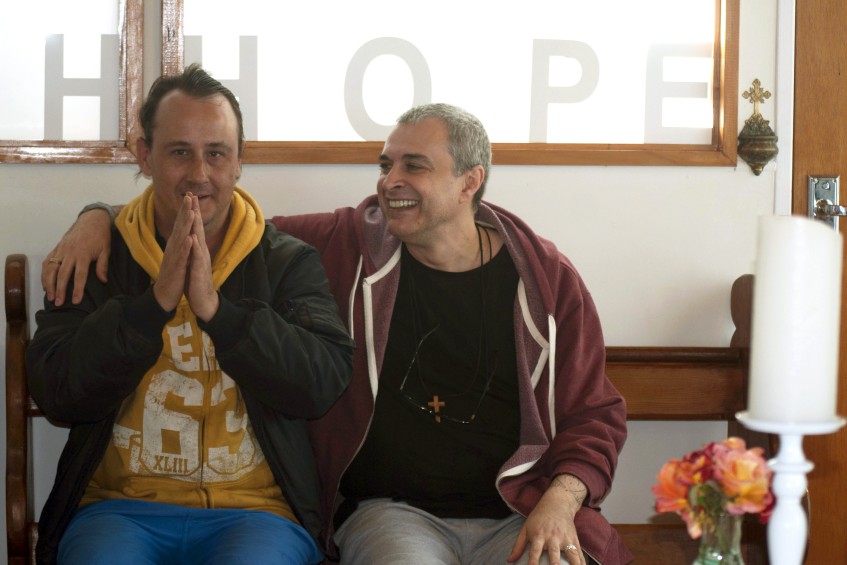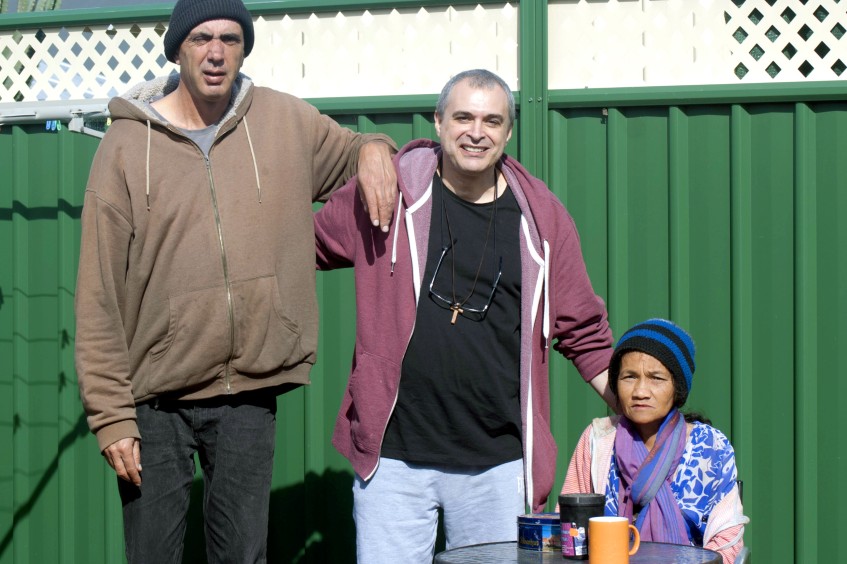2016 LIFELINK WINTER APPEAL: Emmaus builds on inclusive culture

Founder of the LifeLink supported agency of the Archdiocese of Perth, Brother Al Archer with members of the Emmaus Community. Twenty years after it was established as a place of accommodation and support for people who were homeless or suffering poor mental health, the Emmaus Community is still going strong, with a building project underway which is set to increase its living space. Photo: Caroline Smith.
By Caroline Smith
Twenty years after it was established as a place of accommodation and support for people who were homeless or suffering poor mental health, the Emmaus Community is still going strong, with a building project under way which is set to increase its living space.
Founder and director, Brother Alan Archer, - better known as Brother Al - said he hoped the new buildings would help extend and re-shape the community, and make it a bigger presence in Queens Park.
“We’re building four houses which, when they’re finished, will be accommodating 50 community members,” he said.
“They should be finished at the end of September. So, the plan in the next two years is just to unite what we have, and just make this community flow, and flow onto others as well.”
When Br Al purchased the original Emmaus Community property in 1996, it came on the back of his experience working for a Crisis Care Unit in Bentley.
While there, he noticed that many people returned to the unit after their allotted eight weeks of emergency accommodation and care were up, making it clear that this amount of time was not enough for people to recover and rebuild their lives.
Motivated by this, Br Al decided to provide a place where people with mental health issues could live comfortably and recover at their own pace, with the benefit of having others around them.
Initially, the Queens Park property housed only seven people, plus Br Al. But even then, the wider community was supportive and friendly, he said.
“Neighbours and locals are accepting of the community,” he said.
“That’s the one thing that we’re trying to get across, that Emmaus is an inclusive place, and the wider community has accepted it. They love visiting, and our parishioners are very good to us.”

The stories of how people come to Emmaus are varied, but all underscore the importance of being inclusive and not labelling people, Br Al said.
“Each person who comes in has an amazing story,” he said.
“There was a gentleman who’s been with us for 12 years and, when I first saw him, he was living in a garage and they were charging him almost all of his pension. He was in a terrible way physically, but beyond that you saw the soul, and this soul just shone.
“I didn’t have a room at that time but I put him in our van and took him to our art room - he’s been with us ever since.”
He added that the inclusive culture of Emmaus extended to its approach to faith, with a small chapel which people can use if they want to, and which is open to people of all religious backgrounds.
“When I started the chapel, I’ve never to this day asked someone to come to chapel, but always welcomed them if they want to come,” Br Al said.
“So, they see this love, and they want to know what this love is about, and it’s about Jesus – and Jesus’ message is about being inclusive.
“For people on the fringes, feeling included is what they need. With all large religions, we tend to get a bit exclusive but people like Pope Francis and Archbishop Tim and Emeritus Archbishop Barry – who says Mass here once a month – show us what being inclusive is about, and that’s the leadership that we need in the Church.”
Br Al said that, for many people at Emmaus, the chapel was a place of peace, which also reflected inclusivity through its design and services.
“People come here – not always Christians – and they say to me that they feel a great peace,” Br Al said.
“Although it’s a Catholic chapel, it’s inclusive. Everyone is welcome – we’ve had Buddhist monks, Muslim people, Jewish people, people of no faith.
“And it’s in the round – so we share at the table with Christ. I find that people feel very much at home and they can express themselves.
“Our services are very open – even when Archbishop Tim came, one of our community stood up and had a bit of a spiel, but it was beautiful – everyone could see the love from that person and from Archbishop Tim. It’s just spreading that message.”
